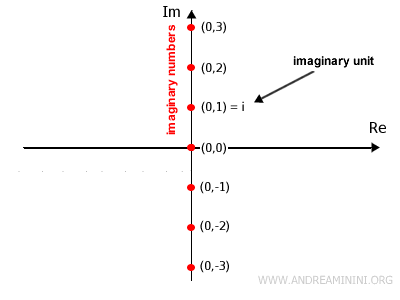Imaginary Unit in Complex Numbers
The imaginary unit is the complex number (0,1), represented by the letter i: $$ i = (0,1) $$. The square of the imaginary unit equals the real number -1: $$ i^2 = -1 $$
The imaginary unit belongs to the set of imaginary numbers.
On the Gaussian plane, it is located at the coordinates (0,1).

Note: In mathematics, the imaginary unit is commonly denoted by the lowercase letter i. In engineering, however, it is often written as the lowercase letter j. Despite the difference in notation, they are equivalent: $$ i = j = (0,1) $$
What is the imaginary unit used for?
The imaginary unit is extremely useful because its square is -1:
$$ i^2 = (0,1)^2 = -1 $$
Proof: To compute the square of the imaginary unit (0,1)2, multiply (0,1) by itself: $$ (0,1)^2 = (0,1) \cdot (0,1) $$ Perform the complex number multiplication: $$ (0,1)^2 = (0 \cdot 0 - 1 \cdot 1, 0 \cdot 1 + 1 \cdot 0) $$ $$ (0,1)^2 = (0 - 1, 0 + 0) $$ $$ (0,1)^2 = (-1, 0) $$ The final result is the real number -1. Therefore, the square of the imaginary unit i = (0,1) is i2 = -1.
This unique property of the imaginary unit makes it possible to calculate the square root of negative numbers.
A Practical Example
The square root of the negative real number -16 cannot be calculated using real numbers:
$$ x = \sqrt{-16} $$
However, this problem can be solved using complex numbers.
Rewrite the radicand in an equivalent form:
$$ x = \sqrt{-1 \cdot 16} $$
Since the square of the imaginary unit is -1 (i2 = -1),
replace -1 with i2 in the radicand:
$$ x = \sqrt{i^2 \cdot 16} $$
The square of the imaginary unit allows us to take it out of the square root:
$$ x = i \cdot \sqrt{16} $$
The radicand is now a positive real number (16).
This allows us to compute the square root: √16 = 4
$$ x = \pm 4 \cdot i $$
$$ x = 0 \pm 4 \cdot i $$
Thus, the solutions to the square root of -16 are:
$$ x = \sqrt{-16} = \begin{cases} 0+4i \\ \\ 0-4i \end{cases} $$
The solutions to the square root of -16 are the conjugate complex numbers 0+4i and 0-4i.
Properties of the Imaginary Unit
The imaginary unit has the following properties:
- The square of the imaginary unit equals the real number -1: $$ i^2 = (0,1)^2 = -1 $$
- The product of the imaginary unit (0,1) and any real complex number (a,0) is always an imaginary number of the form (0,a): $$ (a,0) \cdot (0,1) = (0,a) $$
Proof: To verify this property, perform the complex number multiplication: $$ (a,0) \cdot (0,1) = (a \cdot 0 - 0 \cdot 1, a \cdot 1 + 0 \cdot 0) $$ $$ (a,0) \cdot (0,1) = (0 - 0, a + 0) $$ $$ (a,0) \cdot (0,1) = (0, a) $$
Example
Multiply the real complex number z = (7,0) by the imaginary unit i = (0,1):
$$ z \cdot i = (7,0) \cdot (0,1) $$ $$ z \cdot i = (7 \cdot 0 - 0 \cdot 1, 7 \cdot 1 + 0 \cdot 0) $$ $$ z \cdot i = (0 - 0, 7 + 0) $$ $$ z \cdot i = (0, 7) $$
The result is another imaginary number.
And so on.
